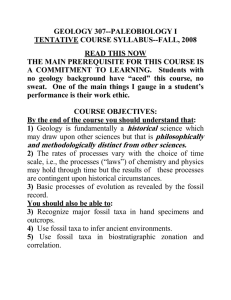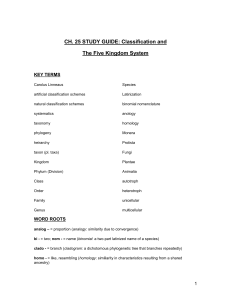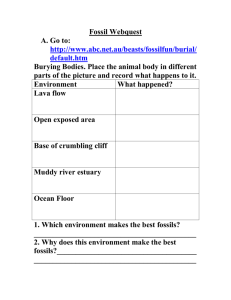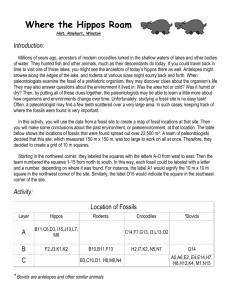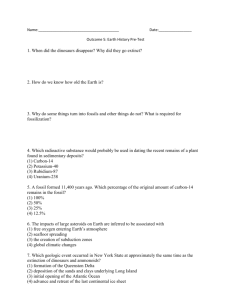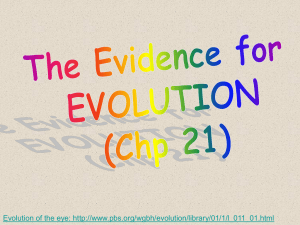Things to know about your GEOL4030 individual project
advertisement
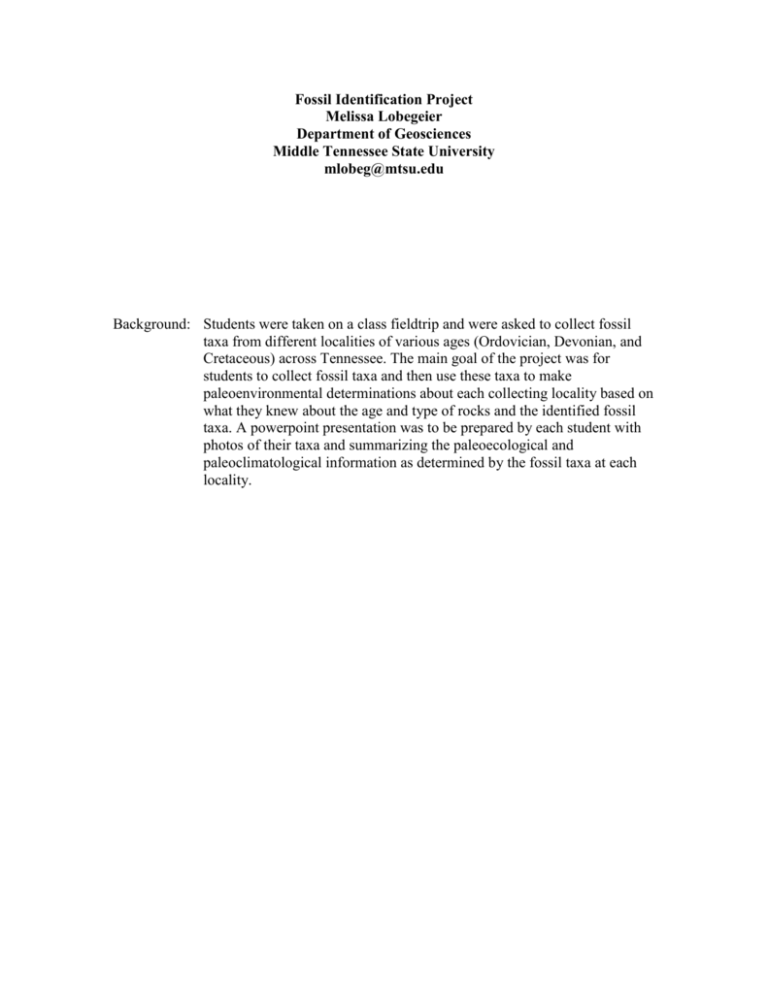
Fossil Identification Project Melissa Lobegeier Department of Geosciences Middle Tennessee State University mlobeg@mtsu.edu Background: Students were taken on a class fieldtrip and were asked to collect fossil taxa from different localities of various ages (Ordovician, Devonian, and Cretaceous) across Tennessee. The main goal of the project was for students to collect fossil taxa and then use these taxa to make paleoenvironmental determinations about each collecting locality based on what they knew about the age and type of rocks and the identified fossil taxa. A powerpoint presentation was to be prepared by each student with photos of their taxa and summarizing the paleoecological and paleoclimatological information as determined by the fossil taxa at each locality. Things to know about your GEOL4030 individual project A. You will collect, identify and catalogue twenty (20) different taxa as indicated below. B. Specifications for your collection: (a) you must include taxa from at least four faunal groups (e.g. Anthozoa, Brachiopoda, Bryozoa, and Gastropoda)* (b) you must include taxa from at least three geologic periods (c) you must include fossils from at least two different Formations for at least one of those geologic periods (d) you must include at least five different locations * Trace fossils are acceptable; however, you must still have at least three additional faunal groups C. Fossils that have weathered free from rock are preferable. Fossils on similarly sized rock slabs are also good. In either case, however, you should choose those that are relatively in-place (not “float”) so that you can easily identify the horizon from which they weathered. If you want to use samples larger than 4” by 4” please consult me first. D. Ten samples will remain with (i.e. you donate them) the MTSU geoscience department collection, so you may want to collect an extra sample or two whenever possible; the donated samples must be identified to species level. E. As you decide which samples to donate, you will need to compare them to a master list to make sure at least five are unique (i.e. no other student is donating that species). The master list will be kept in KOM-300 and it is your responsibility to check it and add your samples to the list. F. Identifications can be made using a variety of sources (these will be discussed in class) including the Treatise on Invertebrate Paleontology (on reserve in the library). G. When collecting, you should mark your samples with locality, formation, and horizon data. You can bring along index cards to write this on, and then put them into a paper sack, Ziploc bag, or envelope with the samples. H. Fossil locality MUST be recorded at the time the sample is collected. For roadside outcrops, the locality at a minimum should consist of either of the following in addition to the highway name/number and an approximate vicinity (Manchester, TN): (a) if available, the estimated mile marker of the location using sign posts and an odometer reading; (b) estimated distance (odometer reading) from an intersection with another major road or from an easily located geographic location (e.g. a small town) For localities remote from a major road, you should either carefully estimate latitude and longitude from a geographic quadrangle or use a GPS. I. Stratigraphic formations should be recorded at the time the sample is collected, if possible. However, this can be determined later using a geologic quadrangle if you have good locality data. J. You should indicate the horizon (outcrop interval) from which you obtained the sample. This can be done most easily by estimating the height (above the base) from which the sample came. Alternatively you can say something like “2nd sandstone unit above the base” so long as the unit is not very thick (e.g. 5 feet or less). This instead might require “six feet above the base of the third shale unit.” K. Every sample must be accompanied with a completed curation label (these will be provided). L. I am NOT providing storage space for uncurated samples here in the department. This is simply because in the past some students have dumped tons (literally) of uncurated rock and fossil samples in the department and simply abandoned them when their time here came to a close. So store your samples at home until they are completely curated and ready to hand in. M. All samples should be in an (a) envelope, (b) paper sack, (c) Ziploc bag, (d) egg carton, or (e) cardboard box. Loose samples are unacceptable. Your entire collection should be in an appropriately sized cardboard box with your name on it. N. When you hand in your collection, the fossils you have designated for donation should be in a separate box and labeled accordingly (e.g. “FOR GEOSCIENCES DEPT.”) In other words, your intent should be obvious without me having to ferret through individual containers, or be left to my imagination. Even if you don’t want any of your samples back, I still would appreciate it if you separate them out so that the best quality and most unique samples are labeled for donation. (And on behalf of the department, and future GEOL4030 students – THANKS!) NOTE: PLEASE!!! Do not use permanent marker to label your specimens. Permanent marker cannot be removed from specimens in many cases. THANK-YOU. GEOL4030 individual project For the final part of your project you are to develop a power point presentation for your collection. The power point should be a minimum of 25 slides (no more than 35) and include the following information: You will need to include the geographic location, the geologic time period represented at that location, the Formation from which the fossils are collected and the fossil fauna. Your presentation should be organized starting with the oldest location and work forward to the youngest location. In your presentation, clearly show relationships between the organisms and the ecology and climate of the sampling locations. You will not have to present these in class. You may use bullets, outlines, or anything else that conveys the information. However spelling, capitalization, and punctuation errors will be counted. If you are not familiar with Microsoft or PowerPoint, please see me as soon as possible and I can get you started. 1. Introduction Include a map of Tennessee with the collecting locations. For each of your 5 or more collecting locations: 2. Collecting Location What is the location of your collecting site as outlined in point H above? 3. Geologic Time Period and Formation Name of the Formation and information about the rock types included in that formation should be given. 4. Fossil Fauna from that location/Formation Photos or sketches of your fossils should be included along with names identified to species level. Include information about the preservation of the fossils. 5. Paleoecology/paleoclimatology This should be as determined by the fossil fauna 6. Further Work What further work should be done to clarify the paleoecology and paleoclimatology of this location. **You will all be collecting from similar locations but I expect your presentations to be unique. You must include citations for any information that you use. You may include a citation slide that is not counted in the slide requirements, or you may include citations with the information on each slide. If you are unsure about how to site any of the information, please ask. The style does not matter as long as you are consistent. Also, cite all maps and figures. The power points are to be turned into me, by uploading them into the project folder in the DROPBOX located on D2L. No power points will be accepted as hardcopies or via email. The DROPBOX will close at 5:00 PM on May 2nd. I will not accept any assignments after that.
